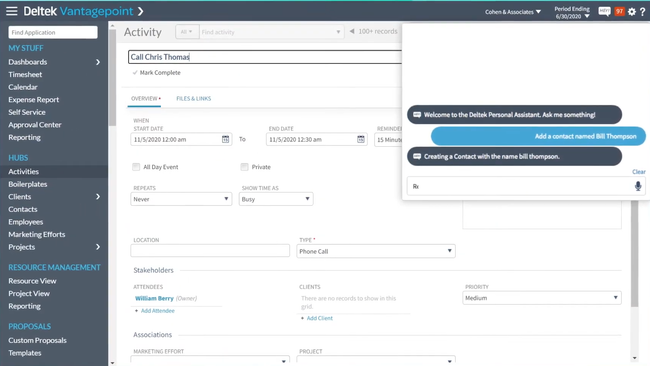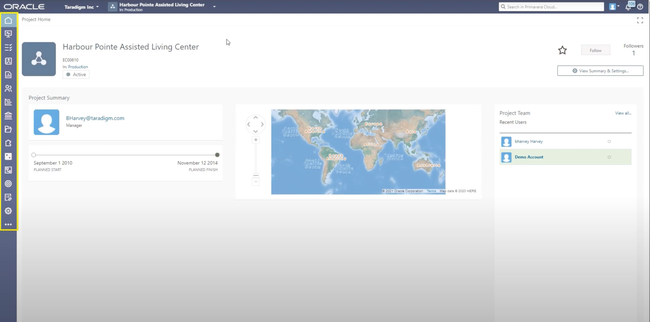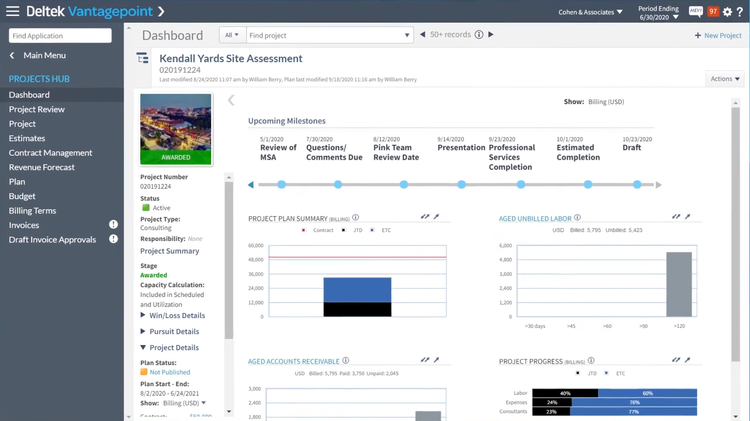The Best Enterprise Project Management Software
We tested a handful of the top enterprise project management software on the market and ranked our favorites.

- Offers detailed project view and financial analysis
- Supports complex and diverse billing requirements
- Provides multi-currency support

- The system can identify and mitigate risks, preventing schedule inconsistencies and cost overrruns
- Ensures compliance with political and environmental regulations
- Can identify areas where costs can be reduced

- Integrates with 400+ apps, including Miro, Jotform, Teams, Google Drive, and SAML
- Offers a free option to individuals and small teams
- Provides various dashboard views like Gantt charts, Kanban boards, and calendars
Project management software can help enterprises better manage, plan, and organize their projects through scheduling, progress tracking, and communication tools. We used our review methodology to review and rank our top choices below.
- Deltek Vantagepoint: Best Overall
- Oracle Primavera P6 EPPM: Best for Engineering
- Wrike: Best for Digital Agencies
Deltek Vantagepoint - Best Overall
The resource planning and staffing tool in Deltek Vantagepoint positions it as an enterprise-level project management software. Going beyond basic Gantt charts or scheduling, it lets you assign staff to projects based on role, skill set, and availability. Vantagepoint continuously updates those assignments as scopes shift or employees’ workloads change.
Additionally, managers can view real-time utilization rates broken down by billable versus non-billable work and projected revenue impact. The system also tracks capacity across business units, highlighting potential conflicts before problems ever arise. Your managers can then quickly reallocate resources or shift timelines and see how those adjustments cascade through schedules and cost projections.
In this way, Vantagepoint resolves three critical challenges:
- Profitability leakage: Resource planning aligns skills & rates with the right project phase.
- Staff burnout: Workload balancing surfaces when a team is stretched too thin.
- Client satisfaction: Forecasts tied to realistic staffing plans ensure projects are delivered on time.
Overall, Vantagepoint is a solid pick for mid to large-sized architecture, engineering, healthcare, and industrial engineering firms.
Oracle Primavera P6 EPPM - Best for Engineering
The baseline and variance control features in Oracle Primavera P6 turn schedules into enforceable contracts. When you stand up a project, you can define working time with a calendar, build the WBS that mirrors your deliverables, lay out activities, and connect them with real logic. Then you take a snapshot, or the baseline, which freezes the planned dates, durations, and cost assumptions before work ever starts.
Unlike lighter PM tools where plans drift as teams edit tasks, Primavera protects the baseline and compares every schedule calculation back to it in real time. Your schedulers assign labor, materials, and non-labor to activities. Then, they can record expected and actual costs at the activity level and update start/finish, percent complete, and the remaining duration. As soon as they press Schedule, P6 recalculates the network and shows variances to the baseline directly on Gantt bars and in tables. That way, you can see which design packages are veering off the critical path and which vendors are compressing your float.
Oracle Primavera P6 starts at $2,750/user for lifetime access. However, there is also an annual maintenance fee of $605/user for updates and support. While Primavera P6 is only available as an on-premise software, Oracle also offers a Primavera Cloud version.
Wrike - Best for Digital Agencies
Wrike’s proofing and approvals tool keeps your creative teams, account managers, and clients aligned without wasting time in back-and-forth email threads. When your staff uploads a new campaign asset to Wrike, reviewers can open it directly in the system, annotate it in context, and highlight specific time stamps or design areas. Because this enterprise project management system supports more than 30 file types, you never have to download and re-upload assets just to review them.
Additionally, Wrike includes a streamlined, traceable approval flow, where your managers can set up an automated sequence: for example, a creative director must review first, then legal, then the client. Each step unlocks the next, so you always know who is holding up the process and how long approvals take on average. When you’re managing several campaigns at once, this can make the difference between projects slipping silently and campaigns being surfaced early enough to fix before a deadline.
Wrike’s proofing module also links directly into resource planning and time tracking. As every revision round is timestamped, those hours roll automatically into your project financials. That way, if a client exceeds the contracted number of revisions, the system can pull hard data to support a change order or additional billing.
Wrike offers a free plan, though larger companies will need the Enterprise or Pinnacle plans. Both require a consultation call for exact pricing.
What Is Enterprise Project Management Software?
Enterprise project management software coordinates the execution of complex project tasks, including planning, scheduling, resource allocation, quality management, time tracking, and collaborative document sharing. This specific type of project management software is intended for use by larger businesses and enterprises – making it better suited to handle larger projects with longer timeframes and increased users.
Sometimes referred to as enterprise project portfolio management software, these solutions focus more on identifying project risks, monitoring project progress, analyzing performance metrics, and improving project quality. This “big picture” approach is best suited for working with bigger teams that deal with a larger volume of projects and is mostly reserved for situations where a standard project management solution would not suffice.
Key Features
- Team Collaboration : Allows two or more users to collaborate on the same project, seeing updates and edits to files in real-time.
- Time Tracking: Track hours spent on individual tasks and the project as a whole. Monitor billable vs nonbillable hours for improved budgeting.
- Reporting: Create summary overviews of a project’s current status. This includes status reports, risk reports, board reports, variance reports, Gantt charts, and PERT charts.
- Budgeting: Estimate the total cost of a project. Includes labor costs, material procurement costs, and operating costs.
- Billing and Invoicing: Prepare and send out client invoices, maintain cash flow, and measure project profitability through planning, execution, and analysis.
- Project Planning and Scheduling: Assign tasks to complete projects by allocating resources within a timeframe.

Primary Benefits
Increase Efficiency Through Maximized Engagement
Your enterprise project management software should provide a return on investment quickly through improved efficiency from your workers. Project managers and employees can easily communicate the kind of work they are dealing with, how long before completion, and if they require any assistance This is made possible via real-time interactive Gantt charts, which visually organize all tasks and resources. Your project team can create milestones, dependencies, and critical paths so everyone can work better together.
Providing visibility into all of your team’s pending and completed tasks will let everyone know who is required to complete the work, putting friendly pressure and accountability on your staff to finish work on time.
Better Decision-Making Based On Data
Enterprises constantly make tough decisions based on project performance, results, and other factors. These decisions greatly impact company financials, human capital, and supply chains. Enterprise project management solutions can help your business overcome challenges by determining which projects should be funded and which should be scrapped.
Likewise, some projects may underperform or require more intervention from your staff and management. This software can help monitor the risk and compliance involved in a particular project – ideally leading to improved profit margins through managed product costs.
Pricing Guide
Enterprise project management software ranges from $75,000 to over $300,000 per year. Most of the time, the reason a PM software becomes “enterprise” is through purchasing an upgraded version with improved functionality that allows for a larger user base.
Many solutions offer free trials to determine which level you need. These options can be used indefinitely but are usually stripped-down versions of their paid counterparts. This means you are usually limited to the number of users and projects that can be used in the system.


























